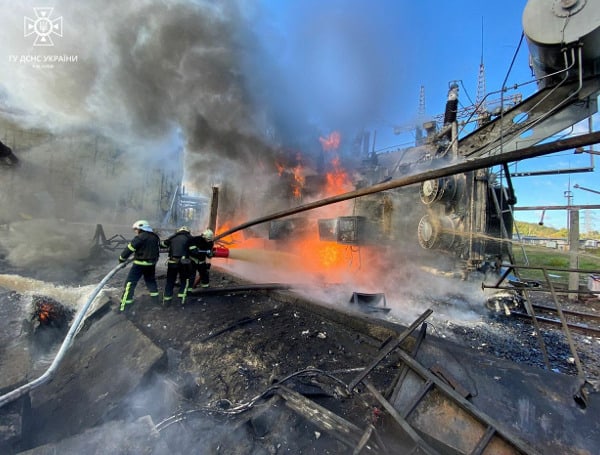While the U.S. has stationed thousands of troops close to the front lines in Ukraine, even before the Russian invasion, revelations of defense personnel operating out of the Embassy in Kyiv suggest the U.S. military involvement has deepened in recent months, experts told the Daily Caller News Foundation.
Since Russia invaded Ukraine in February, the United States deployed thousands of troops into Europe to bolster defense against Russia and support training for Ukrainian troops on the front lines.
In addition, on Oct.31, the Pentagon confirmed that the U.S. had re-deployed an unspecified number of military personnel to the Kyiv embassy — with Pentagon spokesman Brig. Gen. Pat Ryder later emphasized the U.S. has “no combat forces in Ukraine” in an effort to avoid retaliation from Russia.
“But [Russia] will view them as in an adversarial role. If you’re a uniform on the ground, Moscow could say that’s a valid target,” Defense Priorities senior fellow and military expert Daniel Davis told the DCNF.
The State Department released a plan on Oct. 27 for tracking security assistance to Ukraine, which reached nearly $19 billion as of Nov. 4. To do so, Defense Attache Offices (DaTT) and Office of Defense Cooperation (ODC) personnel, who evacuated the Kyiv embassy along with the remaining embassy staff members in February, returned, according to the Pentagon.
In the news: Pregnant Woman Allegedly Loses Baby Due To Unreasonable Employer Demands
Personnel has been conducting oversight activities “within the last couple months,” Ryder told the DCNF in a statement. The Kyiv embassy reopened in May.
Ryder declined to shed light on the number of personnel and their exact duties, saying the return of U.S. personnel did not represent an escalation in U.S. involvement.
“I don’t see a distinction — boots on the ground or military personnel — regardless of what they’re doing. And that’s always been the way it’s been defined,” Mark Cancian, a senior adviser at the Center for Strategic and International Studies, told the DCNF.
The Defense Department’s personnel data center shows 16 active duty servicemembers in Ukraine as of June 30.
In December 2020, there were 38 military personnel in Ukraine, “probably all at the embassy and half consisting of the Marine guard,” whose return to the Kyiv embassy has not been confirmed but are a standard presence at U.S. embassies, Cancian explained.
To properly track U.S. assistance to Ukraine could require a body equivalent to the Special Investigator General for Afghanistan Reconstruction (SIGAR), the organization tasked with monitoring Afghanistan reconstruction assistance, experts told the DCNF.
SIGAR recorded 189 staff members, including at least 30 for in-country operations before the U.S. military withdrawal, according to the latest public budget document.
“I can’t imagine anything less than 50 would even put a dent in the process,” Davis told the DCNF.
In addition, to Russia, their non-combatant role does not change that they are out-sized targets for Russia, Davis explained. ODC conduct arms sales and military training, and defense attaches often serve intelligence collection purposes — all activities Russia has an interest in neutralizing.
It is also “possible” that CIA-backed paramilitary troops are directly involved in the conflict, the Intercept reported, and Davis said.
Cancian expressed doubts, explaining that in the event Russia caught covert U.S. operators in Ukraine, Moscow would widely publicize the event because a U.S. armed forces presence in Ukraine supports Putin’s political objectives.
“I think eventually it would come out. That’s why I don’t think the U.S. would do that,” said Cancian.
Biden has taken pains to reassure Americans that the U.S. will have no military presence within Ukraine, a policy intended to preclude a wider war breaking out on the European continent.
Instead, the Biden administration focused on providing equipment and funding for Ukraine’s military, while stepping up North Atlantic Treaty Organization (NATO) deployments and support activities, according to media reports.
As of February, the European continent housed roughly 80,000 permanent and rotational U.S. troops, including those sent to bolster NATO’s eastern flank, according to Military.com.
Since the Russian invasion, the Department of Defense deployed or extended postings for 20,000 troop members, according to a June 29 memo.
While most U.S. troops are stationed in permanent bases in Germany, Italy, Poland, and the U.K., the U.S. has expanded force capabilities in Spain and several countries in the Baltic region, the memo states.
Approximately 4,700 soldiers in the U.S. Army’s 101st Airborne Division operate in Romania at a base just three miles from Ukraine’s border, arriving on June 20. They’re still in Romania as of October, the U.S. forces nearest to the conflict and fully prepared to cross the border should an attack occur on NATO territory, Colonel Edwin Matthaidess, Commander of the 2nd Brigade Combat Team, told CBS News.
Visit Tampafp.com for Politics, Sports, and National Headlines. Support journalism by clicking here to our GiveSendGo or sign up for our free newsletter by clicking here.
Android Users, Click Here To Download The Free Press App And Never Miss A Story. Follow Us On Facebook Here Or Twitter Here.
Copyright 2022 The Free Press, LLC, tampafp.com. All rights reserved. This material may not be published, broadcast, rewritten, or redistributed.

